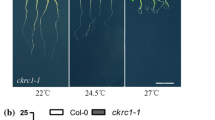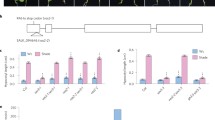Abstract
Hypocotyl growth occurs as a result of an interaction between environmental factors and endogenous phytohormones. In Arabidopsis, high temperature promotes auxin synthesis to increase hypocotyl growth. We previously showed that exogenously provided auxin stimulates expression of the brassinosteroid (BR) biosynthetic gene DWARF4. To determine whether temperature-induced hypocotyl elongation depends on BR biosynthesis, we examined the morphological responses to high temperature and the expression pattern of DWF4pro:GUS in different genetic backgrounds, which are as follows: Ws-2 wild-type, iaa19/msg2, bri1-5, and dwf7-1. In contrast to the wild-type, growth of the three genotypes at 29°C did not significantly increase hypocotyl length; whereas, with the exception of iaa19/msg2, the roots were elongated. These results confirm that BR biosynthesis and signaling pathways are required for hypocotyl growth at high temperature. Furthermore, a GUS histochemical assay revealed that a temperature of 29°C greatly increased DWF4pro:GUS expression in the shoot and root tips compared to a temperature of 22°C. Quantitative measurements of GUS activity in DWF4pro:GUS revealed that growth at 29°C is similar to the level of growth after addition of 100 nM IAA to the medium. Our results suggest that temperature-dependent synthesis of free auxin stimulates BR biosynthesis, particularly via the key biosynthetic gene DWF4, and that the BRs thus synthesized are involved in hypocotyl growth at high temperature.

Similar content being viewed by others
References
Balasubramanian S, Sureshkumar S, Lempe J, Weigel D (2006) Potent induction of Arabidopsis thaliana flowering by elevated growth temperature. PLoS Genet 2:980–989
Blazquez MA, Ahn JH, Weigel D (2003) A thermosensory pathway controlling flowering time in Arabidopsis thaliana. Nat Genet 33:168–171
Blazquez MA, Green R, Nilsson O, Sussman MR, Weigel D (1998) Gibberellins promote flowering of Arabidopsis by activating the LEAFY promoter. Plant Cell 10:791–800
Chung Y, Maharjan PM, Lee O, Fujioka S, Jang S, Kim B, Takatsuto S, Tsujimoto M, Kim H, Cho S, Park T, Cho H, Hwang I, Choe S (2011) Auxin stimulates DWARF4 expression and brassinosteroid biosynthesis in Arabidopsis. Plant J 66:564–578
Clarke SM, Mur LA, Wood JE, Scott IM (2004) Salicylic acid dependent signaling promotes basal thermotolerance but is not essential for acquired thermotolerance in Arabidopsis thaliana. Plant J 38:432–447
Gendreau E, Traas J, Desnos T, Grandjean O, Caboche M, Hofte H (1997) Cellular basis of hypocotyl growth in Arabidopsis thaliana. Plant Physiol 114:295–305
Gray WM, Ostin A, Sandberg G, Romano CP, Estelle M (1998) High temperature promotes auxin-mediated hypocotyl elongation in Arabidopsis. Proc Natl Acad Sci USA 95:7197–7202
Halliday KJ, Whitelam GC (2003) Changes in photoperiod or temperature alter the functional relationships between phytochromes and reveal roles for phyD and phyE. Plant Physiol 131:1913–1920
Jefferson RA, Kavanagh TA, Bevan MW (1987) GUS fusions: beta-glucuronidase as a sensitive and versatile gene fusion marker in higher plants. EMBO J 6:3901–3907
Kim HB, Kwon M, Ryu H, Fujioka S, Takatsuto S, Yoshida S, An CS, Lee I, Hwang I, Choe S (2006) The regulation of DWARF4 expression is likely a critical mechanism in maintaining the homeostasis of bioactive brassinosteroids in Arabidopsis. Plant Physiol 140:548–557
Koini MA, Alvey L, Allen T, Tilley CA, Harberd NP, Whitelam GC, Franklin KA (2009) High temperature-mediated adaptations in plant architecture require the bHLH transcription factor PIF4. Curr Biol 19:408–413
Maharjan PM, Schulz B, Choe S (2011) BIN2/DWF12 antagonistically transduces brassinosteroid and auxin signals in the roots of Arabidopsis. J Plant Biol 54:126–134
Nemhauser JL, Mockler TC, Chory J (2004) Interdependency of brassinosteroid and auxin signaling in Arabidopsis. PLoS Biol 2:1460–1471
Wang SY, Zheng W (2001) Effect of plant growth temperature on antioxidant capacity in strawberry. J Agr Food Chem 49:4977–4982
Yamaguchi-Shinozaki K, Shinozaki K (2006) Transcriptional regulatory networks in cellular responses and tolerance to dehydration and cold stresses. Annu Rev Plant Biol 57:781–803
Acknowledgments
This research was supported in part by grants from the Next-Generation BioGreen 21 Program (Plant Molecular Breeding Center No. PJ008051) and the Cooperative Research Program for Agriculture Science & Technology Development (Project No. PJ906910), Rural Development Administration, Republic of Korea; the Technology Development Program (110033-5) for Agriculture and Forestry, Ministry for Food, Agriculture, Forestry and Fisheries, Republic of Korea, and the Basic Science Research Program through the National Research Foundation of Korea (NRF) as funded by the Ministry of Education, Science and Technology (2010-0012736) (to SC); and the BK21 Research Fellowships funded by the Ministry of Education, Science, and Technology of the Korean Government (to PM) S.D.G.
Author information
Authors and Affiliations
Corresponding author
Rights and permissions
About this article
Cite this article
Maharjan, P.M., Choe, S. High Temperature Stimulates DWARF4 (DWF4) Expression to Increase Hypocotyl Elongation in Arabidopsis . J. Plant Biol. 54, 425–429 (2011). https://doi.org/10.1007/s12374-011-9183-6
Received:
Revised:
Accepted:
Published:
Issue Date:
DOI: https://doi.org/10.1007/s12374-011-9183-6




